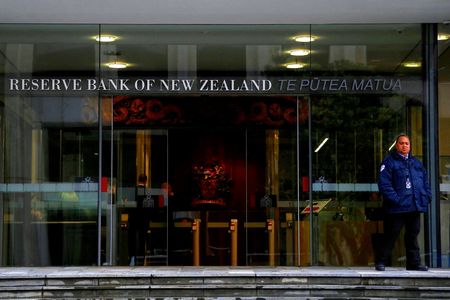By Lucy Craymer
WELLINGTON (Reuters) -New Zealand’s central bank on Wednesday signalled it was done tightening after raising rates by 25 basis points to the highest in more than 14 years at 5.5%, ending its most aggressive hiking cycle since 1999. The Reserve Bank of New Zealand’s (RBNZ) indication the official cash rate (OCR) would now be on hold defied market expectations that it might forecast further hikes and sent the New Zealand dollar down 1.25%.
“The big surprise was leaving the OCR forecast unchanged. It says they’re done (hiking),” said Imre Speizer, head of new strategy at Westpac. “So that is a major surprise.”
He added the statement was very dovish.
The RBNZ forecasts the official cash rate to peak at its current level of 5.5% but will need to remain at the restrictive level until at least the middle of 2024 to ensure inflation returns to a target band of 1% to 3%, according to the monetary policy statement (MPS) accompanying the rate decision. A front-runner among its peers in withdrawing pandemic-era stimulus, the RBNZ has remained singularly focused on curbing inflation, lifting rates by 525 basis points since October 2021. This has been its most aggressive policy tightening streak since the official cash rate was introduced in 1999.
RBNZ Governor Adrian Orr said at a media conference that there were signs higher interest rates were already having the desired effect.
“It is quite nice to see some of the things we were hoping would already be here actually be here. And that is the lower surprise on GDP, the decline in inflation and all the indicators that suggest the interest-sensitive parts of the New Zealand economy are yielding,” he said.
The central bank is still forecasting the economy will shrink in both the second and third quarters of 2023, however the RBNZ sees the recession as shallow and as positive as it reflects slower spending, which will help tame inflation. New Zealand’s annual inflation has come off in recent months and is currently running just below a three-decade high of 6.7%, with expectations it will return to the central bank’s 1% to 3% target within two years.The New Zealand dollar slumped 1.25% to a three-week low of $0.6168 after the rate decision, while benchmark two-year interest rate swaps dropped to 5.1970%, pulling away from a 14-year high of 5.5750% earlier in the day.
Some economists continue to see upside risks to the central bank’s outlook, largely because they see risks around the impact of record migration and the government’s budget on inflation.
Westpac New Zealand chief economist Kelly Eckhold said in a note that a key risk factor was around the RBNZ’s expectation that migration will quickly reverse and not add to housing market or inflation pressures.
“The bottom line is that this is a central bank that sees itself on hold for a protracted period,” he said.
(Reporting by Lucy Craymer; Editing by Tom Hogue and Sonali Paul)





